DAB radio purchasing advice: how to choose the right product
- The most important facts in brief
- Digital radios transmit programmes using digital methods and not only receive DAB or DAB+, but also connect to other devices such as smartphones.
- The successor of the FM radio convinces with a greater programme variety, better sound quality and easier handling.
- In addition to reception and programme selection, consumers should also pay attention to criteria such as power supply, connections and display features when making a purchase.
Digital radios: new sound with old flair
Whether getting up in the morning, in the car on the way to work or on the construction site – the radio is still a popular medium, especially as it is perfect alongside another activity. While some people get in the mood for the day with the right music, others stay informed about the news. In the meantime, however, the radio landscape has moved away from analogue and towards digital transmission. Those who enjoy the old FM radio but still do not want to do without modern technology rely on digital radio, the digital successor system to ultra-short wave. On average, every German listens to about three hours of radio a day – a Statista survey from 2017.
Consumers have to dig deeper into their pockets for a digital radio, but in return they retain the haptic impression of the radio, at the same time they do without the antiquated station search by rotary knob control and, on top of that, they get a better sound because digital transmission eliminates noise and crackling. However, the quality varies depending on the station and data rate, but overall it is close to that of a CD.
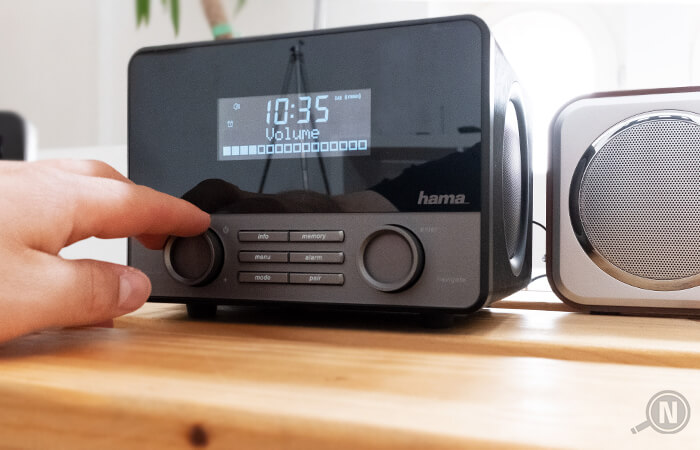
From analogue to digital
Until 1983, analogue networks provided nationwide coverage of radio programmes, but the frequencies 87.5 to 108 MHz in certain regions were no longer able to cope with the growth of new private radio stations. The urgent need for a new technology finally led to the birth of digital radio.
The quality of the source signal is decisive. The data rate varies between 72 and 144 kilobytes per second depending on the federal state and the programme. If the signal is too weak, only silence is audible. In addition, the digital radio switches to FM if the transmission fails.
By transmitting the programmes with digital broadcasting methods and by the fact that the transmission masts already exist, it is an ecological and at the same time economical approach. The beginnings of digital audio broadcasting date back to the 1980s. Modern digital radios not only receive DAB (Digital Audio Broadcast) or DAB+, but also connect to many other receiving devices such as smartphones.
Depending on the federal state, users have access to a comprehensive range of stations with up to 90 channels. While listeners in Thuringia have only 20 stations at their disposal, in Bavaria over 80 programmes are possible. Furthermore, thanks to the radio alarm clock, they can be woken up with music, listen to current headlines, weather reports and traffic information as well as play music from external playback media, such as an MP3 player. In addition, the DAB radio enables wireless connection to WLAN routers, smartphones and hi-fi systems.
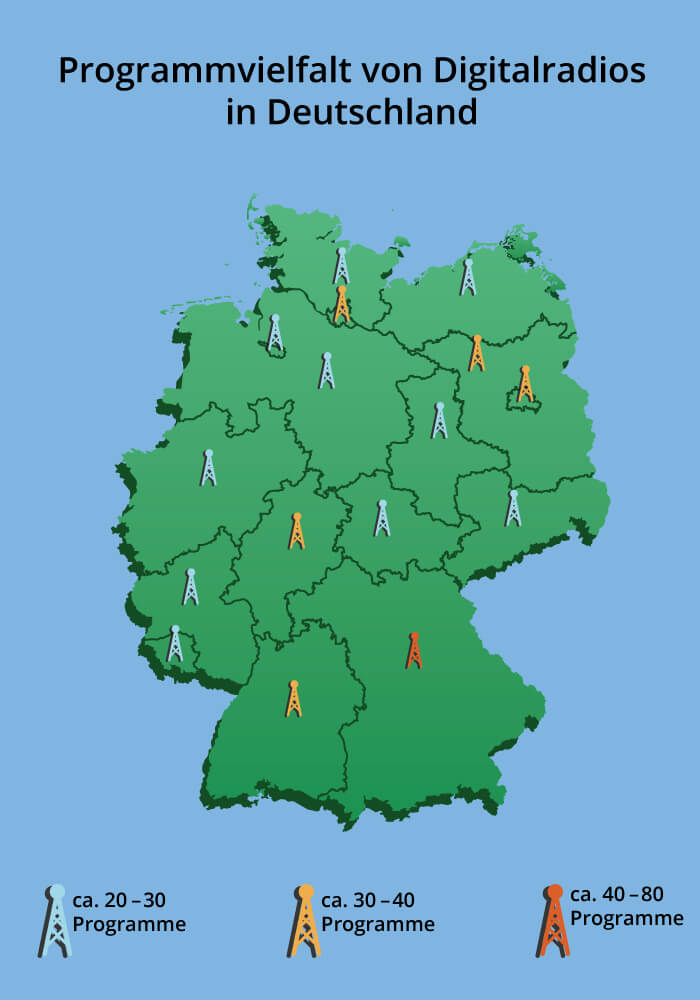
The following table illustrates some of the advantages and disadvantages of digital radios compared to FM radios:
Pro
- Significantly greater programme variety
- Higher sound quality
- Almost interference-free reception
- Additional station information
- Easier operation
- No need to search for stations
Cons
- More expensive than analogue radios
- Programme selection depends on the federal state
From the compact version to the hi-fi variant
Visually, the digital radio hardly differs from its predecessor, as there are models in piano lacquer look as well as in real wood. Nevertheless, some types can be distinguished from each other:
Stationary digital radios
Stationary digital radios often have the most extensive equipment, from remote control and headphone outputs to high-quality speakers. The most popular are the compact stand-alone units, as they can be used universally. They are usually equipped with a small throw antenna or an integrated antenna and a large display.
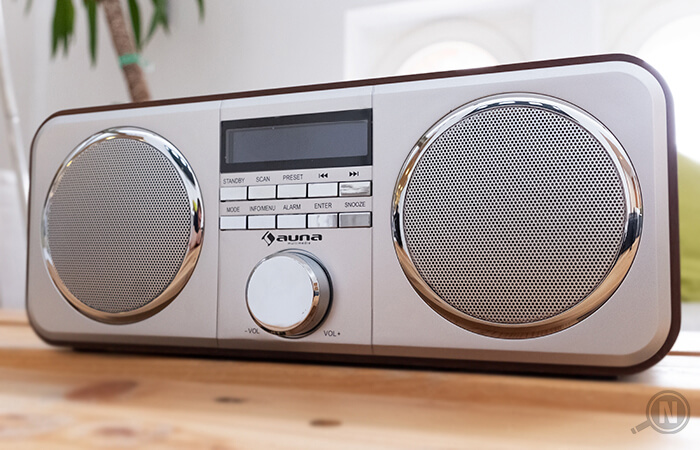
Some renowned manufacturers of hi-fi equipment have developed digital radios in the typical rack format – to accommodate various technical devices – that offer traditional FM and AM reception in addition to DAB(+). Compared to the compact version, these digital radios offer a larger number of station memories and RDS reception. The Radio Data System makes it possible to transmit a lot of additional information during FM broadcasting.
When connecting the digital radio, users can choose between WLAN and a network cable, which gives them access to Internet content. Digital radios with an integrated alarm function, automatic switch-off and USB power port, i.e. a quick charger, make handling much more convenient. There are special radios on the market for kitchen base units that can be mounted under wall cabinets. These radios have a display and loudspeakers on the front. It is not uncommon for them to also have a kitchen clock. Another practical additional function is a CD compartment, which means that users can dispense with an additional CD player.
Digital radios for on the road
While construction site radios are designed to be particularly robust, waterproof and extremely resistant to dirt and have a powerful sound, the more compact portable pocket radios are suitable for jogging or going to the beach. An integrated rechargeable battery, a clip function for a secure hold on clothing and a key lock function are just as much in demand here as a headphone input.
Since DAB+ does not require Internet access, the signal can also be received in the car. A particularly practical feature here is the automatic frequency search, which simplifies the programme setting considerably. Some devices also offer combined systems with navigation and DAB+ reception. Current traffic information is provided by means of TPEG service, which transmits news faster, more extensively and more precisely.
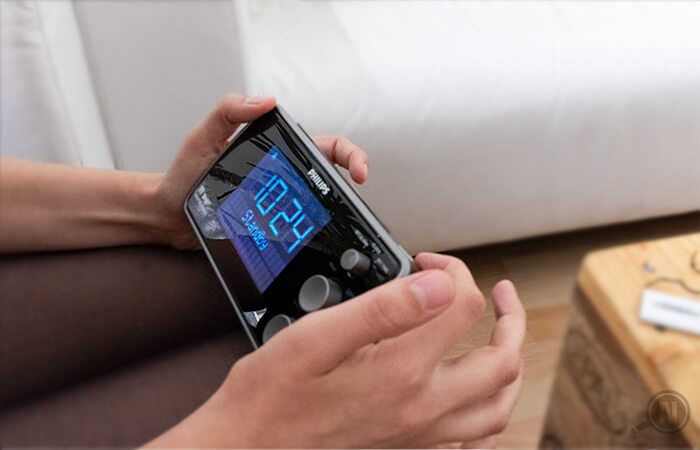
TPEG refers to the data protocol of the Transport Protocol Experts Group, which provides solutions for detailed traffic information. The standard installation of a DAB car radio is not yet given in Germany, but usually the radio can be installed in the DIN socket.
Digital radio adapter
Many manufacturers offer DAB+ adapters to convert a conventional analogue radio, a stereo system aor even a car radio. The scope of delivery includes the appropriate audio cables to connect the adapter output to the free audio input of the FM radio. Due to its handy size, the adapter can also be placed directly on the device. After users have pulled out the antenna and selected the external audio input on the stereo system, the automatic station scan starts. The adapter can be controlled with a remote control.
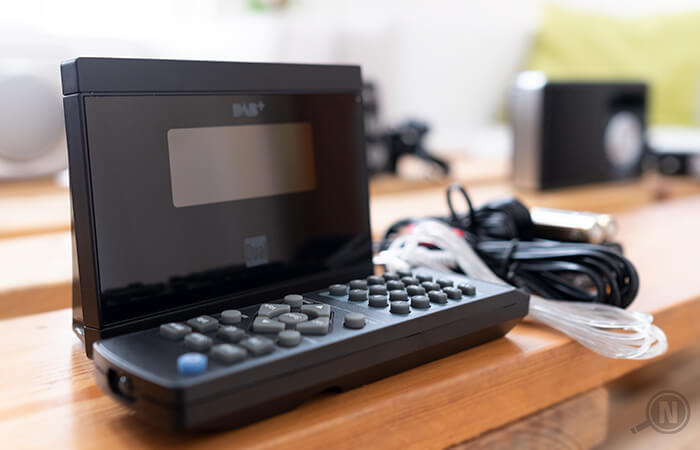
FM, DAB and Co.: The reception ranges
Conventional radios transmit audio data via VHF, i.e. ultra short waves, or FM as they are called in English. DAB is the technology for receiving digital audio signals via antenna. Users receive not only local and regional, but also nationwide radio programmes. Since reception is independent of the internet, DAB is neither a burden on the wallet nor on data quotas, as is the case with smartphones. At the same time, the standard can be received by any number of terminals simultaneously without loss of quality. Hybrid terminals receive radio broadcasts via several distribution channels, i.e. DAB as well as FM and the internet.
Digital terrestrial radio DAB+ provides listeners with even better sound quality and more station information and is also more robust against environmental influences and interference signals. Digital radios that have been on the market since the start of the DAB+ standard support both variants. By the end of 2018, DAB+ will be available in 97 percent of Germany. The goal is to expand the transmission network as completely as possible by 2020. At least the motorways are almost completely covered with a total of 98 percent.
RDA stands for “Radio Data System” and enables the transmission of various additional information from date and time to news and pictures. The narrow-band digital broadcasting system DRM (Digital Radio Mondiale) transmits programmes worldwide and distributes its content on the old long, medium and short wave frequencies by using OFDM/COFDM transmitters.
Reception and its sources of interference
DAB abroadMore than half of Europeans now have access to DAB+ reception, so the chances are good that they will also be able to receive the corresponding station abroad. In some countries – such as Switzerland and Norway – DAB+ has already been introduced nationwide.
It is not possible to receive digital radio with an FM radio. Instead, users need a specially designed DAB radio that automatically searches for receivable stations. Since DAB+ is broadcast terrestrially, i.e. the signals are transmitted by transmitters, they only have a limited range. The transmission area depends on the type and number of transmitting stations. In order to have good reception at home, a high transmission power is necessary so that the signal penetrates the wall. Since the signal strength varies depending on the location, reception indoors is sometimes not strong enough. Often, DAB+ reception is only possible with an antenna upgrade of the radio set.
Building attenuation, i.e. steel beams, neighbouring houses or damped windows, can also be a problem. In addition, poorly shielded electromagnetic devices, cable systems or LED lights impair reception. For this reason, it is often worthwhile to relocate the digital radio, for example near a window. Even storms and snowfall can have a negative effect on reception. Of course, the quality of the device always plays a role in the signal strength.
Additional services
Depending on the type of device, the digital radio is capable of receiving various additional services. These include the following:
- DSL(+): The Dynamic Label Service provides programme-accompanying information such as song titles and artists, which appear on the display and are stored.
- EPG: The Electronic Program Guide provides an overview with the help of a detailed programme overview.
- SLS: The Slideshow Service shows picture information such as station logos and album covers on the display. The RADIO VIS application also provides pictures that match the programme on the radio display.
- TPEG: The Transport Protocol Experts Group transmits current traffic information quickly and precisely.
- FILE COLLECTOR: The tool not only enables reception, but also storage of audio files accompanying the programme.
- JOURNALINE: The service provides information such as stock exchange data or sports results parallel to the programme.
- BWS: The broadcast website supplements the display with various web pages.
- ANNOUNCEMENTS: The danger and traffic reports switch on automatically when the user is listening to a CD.
What to look for when buying
A digital radio comes with a number of advantages. Reception and programme variety seem to be the most important criteria, but those who want to invest more can also attach importance to the little extras. When buying a digital radio, pay special attention to the following criteria:
The power supply
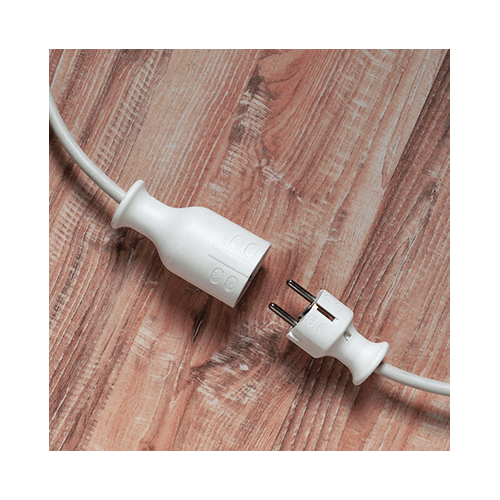
There are basically three variants: Mains adapter, rechargeable battery and battery, whereby the supply via a mains cable is the standard. The main advantage is the lack of battery and rechargeable battery replacement. However, the latter are also suitable for on the road. At best, the digital radio not only has a mains adapter, but can also be powered by batteries.
The connections
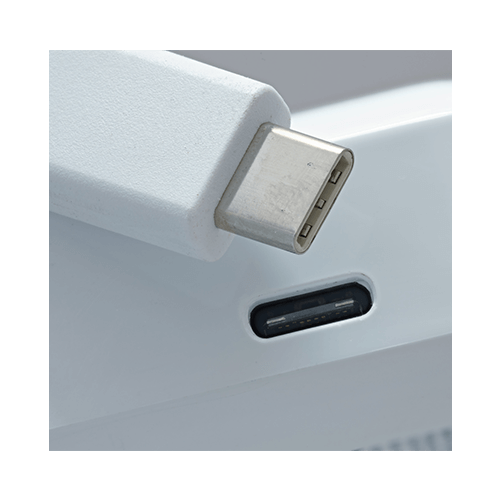
The more connections the device has, the more functional it is. A universal headphone connection is practical. A line-in connection is suitable for connecting to a hi-fi system. Equally useful are an AUX connection, a 3.5-millimetre jack for an MP3 player and a USB or micro-USB connection, e.g. for smartphones.
Radio transmission
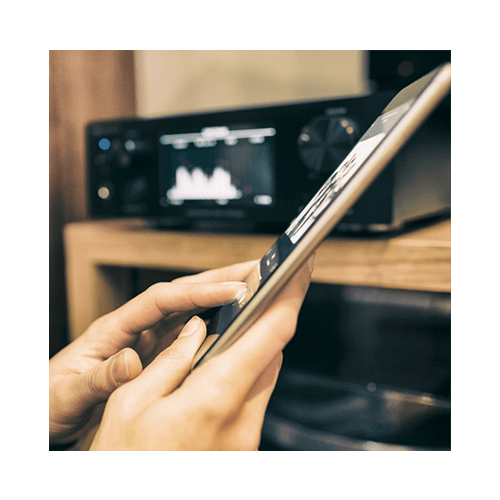
Some DAB radios also receive stations via Bluetooth and WLAN, which offers an even greater variety of stations by allowing music to be played via the boxes with other end devices such as a smartphone or tablet.
The power
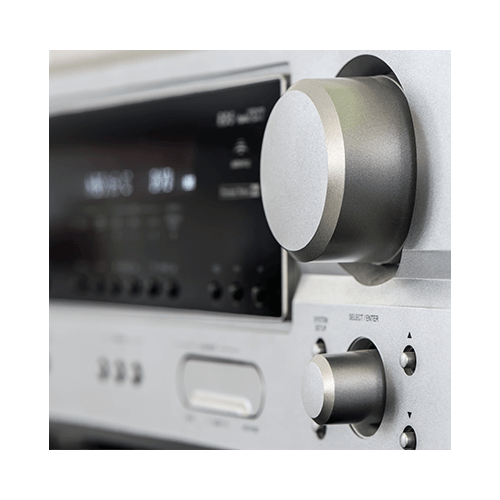
Specified in watts, the power not only provides information about the power consumption, but also about the volume. With inexpensive digital radios, the wattage is usually lower than with high-quality products. Devices with WLAN support and a display also generally consume more power.
Transmit memory
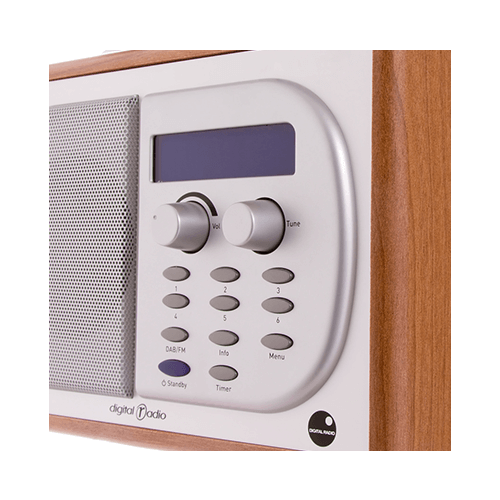
The preset memory allows you to save your favourite programmes and other programmes so that they can be accessed at the touch of a button. As a rule, there are between ten and 20 memory locations.
The Display
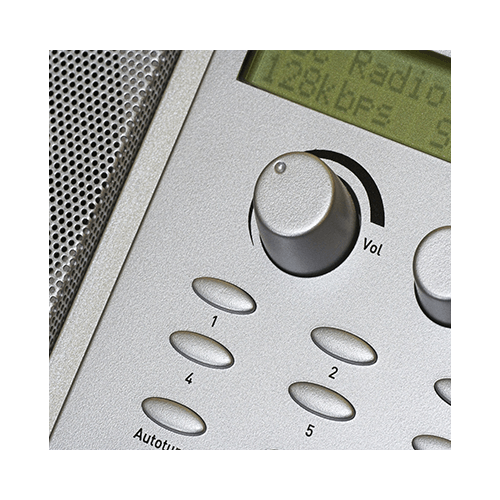
Since the LCD or LED display often shows additional information such as music titles and news in addition to the date and time, the quality should be at least good enough to be easily readable. It is therefore worthwhile, among other things, to pay attention to a backlight. A dimming function that allows users to dim the light as needed is also practical if the device is located in the bedroom, for example.
The remote control
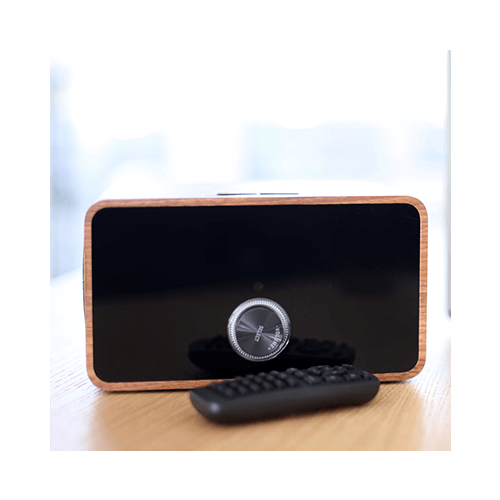
Some digital radios can be controlled via a remote control, which makes it much easier to use. Modern devices offer a free remote control app for smartphones, for example.
The clock
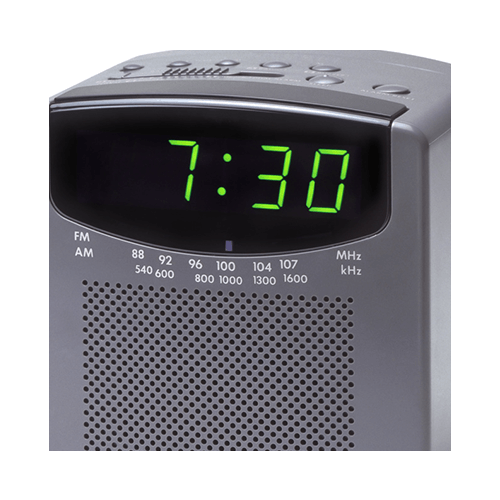
The date and time are transmitted or displayed automatically, so a digital radio can usually also be used as a radio alarm clock. With the help of the sleep time function and automatic switch-off, the music turns itself off after a preset time.
Conclusion: Internet radio – supplement or alternative?
Since the majority of radio stations can now also be found on the web and are therefore only a mouse click away, consumers rightly ask themselves why they should buy a digital radio. However, they do not consider that the internet is a one-to-one connection between transmitter and receiver, whereas with radio, just a few transmitter masts are enough to supply millions of users with music. Consequently, immeasurable storage capacities and correspondingly a lot of money would be required to implement internet-based broadcasting.
Most users of internet radio see it more as a supplement or a change from radio stations, where there is often less music and much more talk from the presenters or advertising. On the internet, consumers also find numerous unusual programme offerings beyond the mainstream. However, the fact that the web offer serves more as a supplement and not as an alternative to digital radio is mainly due to the poor sound quality, which cannot keep up with the competition. Those who do not want to do without the advantages of either Internet or digital radio should consider purchasing a hybrid device that supports WLAN reception in addition to DAB(+) and FM reception.
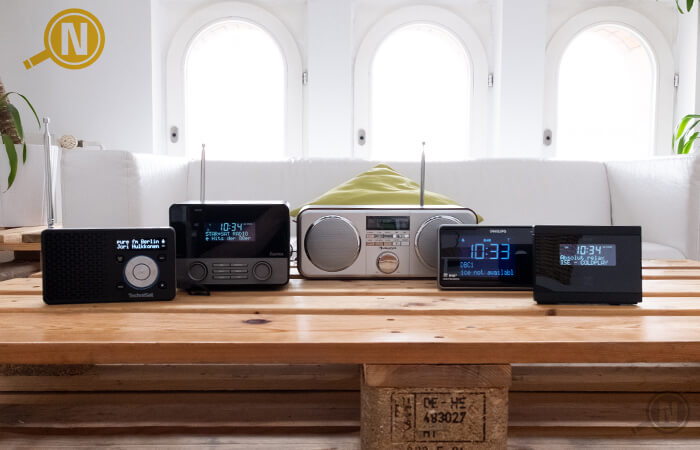

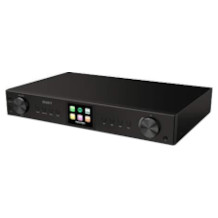
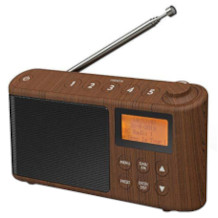
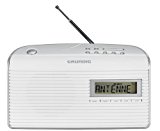
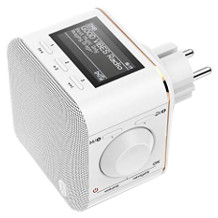
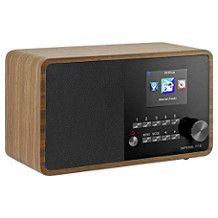
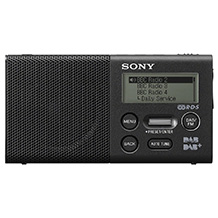
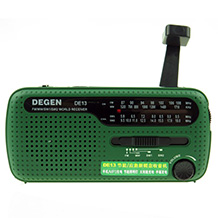
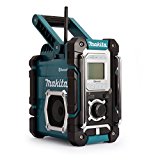

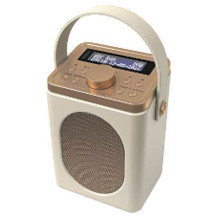
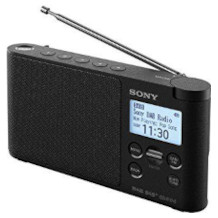
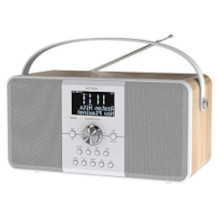

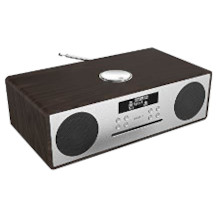
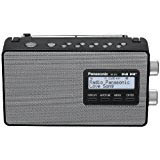
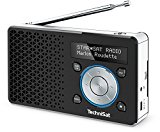
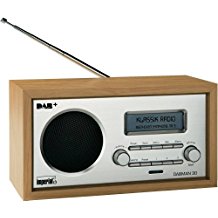
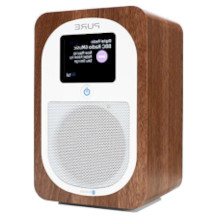
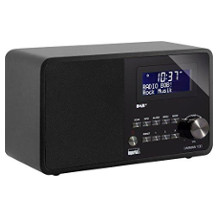

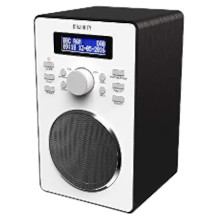
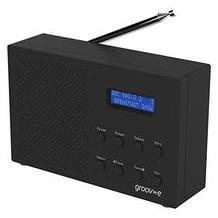

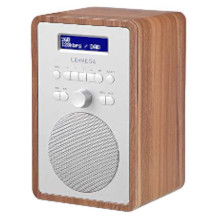

 1,458 reviews
1,458 reviews
